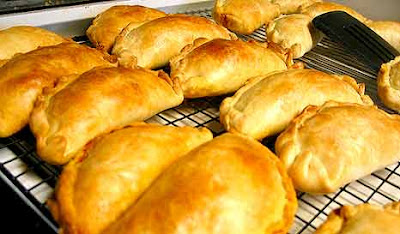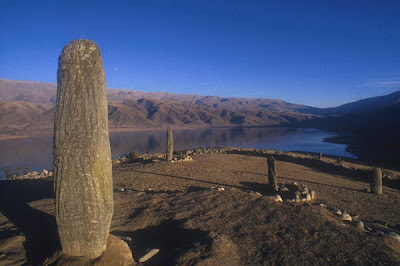Tafi del Valle El Valle name derives from the word kakán "Taktikllakta" (language spoken by the people diaguita calchaquí who inhabited the region since the year 1000), which translates as "site or place of splendid entrance. "
Surrounded by mountains up to 4500 meters high, is located about 107 km from San Miguel de Tucuman and 1,976 meters above sea level.
From San Miguel de Tucumán, access to the valley is the valley of the Rio Los Sosa, with its magnificent subtropical forest, upland forests, flowers vary by season and waterfalls of incredible beauty.
Tafi is a valley with alpine meadow vegetation in semi-arid summer months and the rest of the year, when it lives up to its status as gateway to the valleys calchaquíes, access to the Andean world.
Aboriginal culture (developed three until the arrival of Spanish: Tafi, the diaguita calchaquí and inca) is evident in the stone walls, the archaeological sites, pottery and the megaliths. The colonial period (from the white man's arrival and the onset of stays) is manifested in the adobe buildings, rituals, beliefs, legends and traditions, handicrafts, the production of cheese ...
The National Cheese Festival in days of February, was created to highlight the craftsmanship of the product and to worship everything Creole and traditional.
In a place called The Swamp, which is still accessible only on horseback or on foot, the last week of January is performed Yerbiao Party (based drink mate and alcohol).
Among the traditional products that we acquire in Tafi, plus cheeses include sweets, dried fruits, textiles, regional sweet snacks, manufactures ceramic, antler, wood and rawhide.
The climate of Tafi del Valle is semi arid, dry, warm to cold with snow. Average temperatures are maximum 26 degrees Celsius in summer and 16 degrees in winter.
Easter is recreated in The Passion of Christ, in a natural amphitheater, represented by professional actors and ordinary people.
Surrounded by mountains up to 4500 meters high, is located about 107 km from San Miguel de Tucuman and 1,976 meters above sea level.
From San Miguel de Tucumán, access to the valley is the valley of the Rio Los Sosa, with its magnificent subtropical forest, upland forests, flowers vary by season and waterfalls of incredible beauty.
Tafi is a valley with alpine meadow vegetation in semi-arid summer months and the rest of the year, when it lives up to its status as gateway to the valleys calchaquíes, access to the Andean world.
Aboriginal culture (developed three until the arrival of Spanish: Tafi, the diaguita calchaquí and inca) is evident in the stone walls, the archaeological sites, pottery and the megaliths. The colonial period (from the white man's arrival and the onset of stays) is manifested in the adobe buildings, rituals, beliefs, legends and traditions, handicrafts, the production of cheese ...
The National Cheese Festival in days of February, was created to highlight the craftsmanship of the product and to worship everything Creole and traditional.
In a place called The Swamp, which is still accessible only on horseback or on foot, the last week of January is performed Yerbiao Party (based drink mate and alcohol).
Among the traditional products that we acquire in Tafi, plus cheeses include sweets, dried fruits, textiles, regional sweet snacks, manufactures ceramic, antler, wood and rawhide.
The climate of Tafi del Valle is semi arid, dry, warm to cold with snow. Average temperatures are maximum 26 degrees Celsius in summer and 16 degrees in winter.
Easter is recreated in The Passion of Christ, in a natural amphitheater, represented by professional actors and ordinary people.
Tafi del Valle El Valle name derives from the word kakán "Taktikllakta" (language spoken by the people diaguita calchaquí who inhabited the region since the year 1000), which translates as "site or place of splendid entrance. "
Surrounded by mountains up to 4500 meters high, is located about 107 km from San Miguel de Tucuman and 1,976 meters above sea level.
From San Miguel de Tucumán, access to the valley is the valley of the Rio Los Sosa, with its magnificent subtropical forest, upland forests, flowers vary by season and waterfalls of incredible beauty.
Tafi is a valley with alpine meadow vegetation in semi-arid summer months and the rest of the year, when it lives up to its status as gateway to the valleys calchaquíes, access to the Andean world.
Aboriginal culture (developed three until the arrival of Spanish: Tafi, the diaguita calchaquí and inca) is evident in the stone walls, the archaeological sites, pottery and the megaliths. The colonial period (from the white man's arrival and the onset of stays) is manifested in the adobe buildings, rituals, beliefs, legends and traditions, handicrafts, the production of cheese ...
The National Cheese Festival in days of February, was created to highlight the craftsmanship of the product and to worship everything Creole and traditional.
In a place called The Swamp, which is still accessible only on horseback or on foot, the last week of January is performed Yerbiao Party (based drink mate and alcohol).
Among the traditional products that we acquire in Tafi, plus cheeses include sweets, dried fruits, textiles, regional sweet snacks, manufactures ceramic, antler, wood and rawhide.
The climate of Tafi del Valle is semi arid, dry, warm to cold with snow. Average temperatures are maximum 26 degrees Celsius in summer and 16 degrees in winter.
Easter is recreated in The Passion of Christ, in a natural amphitheater, represented by professional actors and ordinary people.
Surrounded by mountains up to 4500 meters high, is located about 107 km from San Miguel de Tucuman and 1,976 meters above sea level.
From San Miguel de Tucumán, access to the valley is the valley of the Rio Los Sosa, with its magnificent subtropical forest, upland forests, flowers vary by season and waterfalls of incredible beauty.
Tafi is a valley with alpine meadow vegetation in semi-arid summer months and the rest of the year, when it lives up to its status as gateway to the valleys calchaquíes, access to the Andean world.
Aboriginal culture (developed three until the arrival of Spanish: Tafi, the diaguita calchaquí and inca) is evident in the stone walls, the archaeological sites, pottery and the megaliths. The colonial period (from the white man's arrival and the onset of stays) is manifested in the adobe buildings, rituals, beliefs, legends and traditions, handicrafts, the production of cheese ...
The National Cheese Festival in days of February, was created to highlight the craftsmanship of the product and to worship everything Creole and traditional.
In a place called The Swamp, which is still accessible only on horseback or on foot, the last week of January is performed Yerbiao Party (based drink mate and alcohol).
Among the traditional products that we acquire in Tafi, plus cheeses include sweets, dried fruits, textiles, regional sweet snacks, manufactures ceramic, antler, wood and rawhide.
The climate of Tafi del Valle is semi arid, dry, warm to cold with snow. Average temperatures are maximum 26 degrees Celsius in summer and 16 degrees in winter.
Easter is recreated in The Passion of Christ, in a natural amphitheater, represented by professional actors and ordinary people.








1 comments: